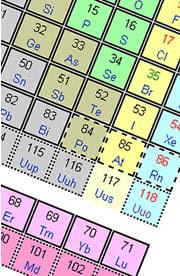 Ununoctium - provisionally slotted into the periodic table.
Ununoctium - provisionally slotted into the periodic table.For the second time in seven years, researchers say they have made the heaviest chemical element ever — the exotically titled ununoctium, or element 118.
In 1999, physicist Victor Ninov, then working at the Lawrence Berkeley National Laboratory in California, claimed to have created element 1181; the team retracted its results two years later amid accusations of falsified data, which Ninov denied. Now, reporting in the journal Physical Review C, researchers in Russia and the United States claim to have succeeded — this time using a different experimental setup2.
The evidence comes in the form of specific isotopes of elements 116, 114 and 112, which are created when element 118 decays. Yuri Oganessian and colleagues at the Joint Institute for Nuclear Research in Dubna, Russia, working with a group at the Lawrence Livermore National Laboratory in California, got the results by bombarding the isotopes curium-245 and californium-249 with a beam of calcium-48 until the atoms fused.
It is this choice of beam and target that made element 118 possible, says Rodi Herzberg, a theoretician at the University of Liverpool, UK. The Dubna laboratory is one of the few in the world able to handle radioactive heavy elements such as californium. This has allowed Oganessian's team to work with heavy elements, but also makes it hard to reproduce the results.
"At this point none of our experiments has been confirmed by another lab," says Ken Moody, leader of the team at the Lawrence Berkeley lab. But, he adds, "everything that we do is checked and double-checked."
Nothing is certain
“The ball is now firmly back in the theoreticians' court.”
Rodi Herzberg, University of Liverpool
In the Dubna work, the beam and target collide with great force, creating high excitation energies in the atomic nuclei. So there's a good chance the atoms will fuse, but the high energies mean they are less likely to survive. Ninov's approach used atoms that were less excited, meaning there was a lower chance of fusion but a higher chance of surviving the process intact. No one has been able to reproduce Ninov's results using his technique, but it is unknown whether the strategy is itself flawed.
No matter how the element is made, confirming it is tricky. Until the Dubna results are reproduced, nothing is certain, warns Fritz Peter Hessberger, a physicist at the Institute for Heavy-Ion Research (the GSI) in Darmstadt, Germany. "These are just claims; the results have never been reproduced," he says. Verifying the experiment is likely to take years, he adds, especially because it is so hard to handle heavy radioactive elements.
Still, the Dubna team has been very methodical about its work, says Herzberg: "This group is making a very valiant effort to provide confirmation." The researchers looked at three possible decay paths of element 118, made the expected decay products separately and studied how those, in turn, decay. They then matched this process with what happened when their proposed element 118 decayed. Other groups can use less-radioactive elements to get to the same daughter products and use them to check the results, Herzberg says.
Gone in a flash
"The ball is now firmly back in the theoreticians' court," he says. "Every single one of these nuclei that get produced gives you an additional stepping stone for theoreticians to hone their methods." In particular, theorists might be able to use the information to better understand the long-sought 'island of stability' — a predicted but never-before-seen group of heavy but unusually stable elements.
ADVERTISEMENT
Another goal is to investigate the chemistry of heavy elements, says Nancy Stoyer of the US team. With just three atoms of element 118 produced in more than 1,000 hours of experiments so far, and with a lifetime of just 0.9 milliseconds, this isn't likely to happen just yet. But Stoyer hopes that an isotope can be made that will last long enough for its chemistry to be studied.
The element will probably remain nameless for quite some time, as ununoctium is only a provisional name. New elements do not receive permanent names until they have been verified and a name approved by the International Union of Pure and Applied Chemistry.
Visit our elementmade_again.html">newsblog to read and post comments about this story.
